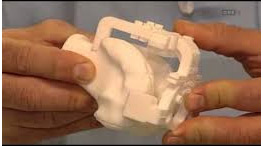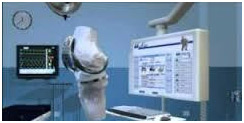The Orthopedic Group of the Greekorthopaedic, N. GRANITSAS, D. TOGANTZI, now treats arthritis of the knees with surgery, using a new revolutionary method, which is first applied in Greece. This is the total knee Arthroplasty, MyKnee, of MEDACTA. MEDACTA, that manufactures MyKnee, is a Swiss quality company, which is known for the total Hip Arthroplasty with the AMIS method.
Many years ago, we used to believe that a damaged knee joint sufficed so that a hinge Arthroplasty device should be placed, restoring the movement. However, the knee is a complex joint that does not just bend and stretch. An important step of progress was the surfacing Arthroplasty that now can be placed with “robotic techniques».
INDICATIONS FOR OPERATION
Total knee Arthroplasty gives excellent results.
In Greece the main cause for total Arthroplasty is degenerative arthritis (osteoarthritis, salts) and to a smaller degree the rheumatoid arthritis, or other Collagen diseases. The sufferer complains about pain and instability when walking. There are international protocols that define what kind of patients need surgery. We follow these protocols and perform operations on people who present an incapability of walking for more than 300 meters, or instability, where patients lose the support of their feet and fall. All the other cases are treated with infusion (injection) of medication inside the knee and with physical exercise.
TYPES OF ARTHROPLASTY
Old “hinge-type” Arthroplasty, except for very special cases, is no longer used. Implants have prevailed, where only the damaged surface of the knee is restored. We usually change the entire surface of the knee, with the exception of a few cases where only the inner side is changed with hemiarthroplasty. The last one represents only the 6% of the total of arthroplasties and has very limited indications. In Greece, patients arrive too late at the doctor’s office, after having destroyed the entire joint. In all these years that we operate, we never had an indication that would guide us to hemiarthroplasty.
SURFACE ARTHROPLASTY
The surgery is consisted in the polygonal removal of the deteriorated surface of the joint, with special guides. We cover it with a metal attachment that moves on a “plastic” meniscus. The knee is aligned and the patients can walk without feeling any pain. Many people have been to the dentist and have had a bonding done to a non-repairable tooth. This is the best metaphor about how it works and what an Arthroplasty is
ROBOTIC TECHNIQUES
Minor variations in the placement of the knee implant with reference to the ideal axis of rotation of the knee, may occur even to the most experienced surgeons. A deviation of a millimeter in the positioning of the implant may result in a reduction of 7 degree of the motion. Robotic techniques have attempted to solve this problem. To be precise, it is about navigating with infrared rays and it operates as a GPS. The surgeon places sensors in some points of the joint and he/she sees the ideal position of the implant on the computer screen.
It goes without saying that the surgeon has to be experienced, to verify each stage and to place all sensors with precision. A good navigation does not necessarily turn a bad surgeon into a good one.
The disadvantages of the method are: the long surgery, the cost and the poor positioning of guides.
OUR CHOICE-RECOMMENDATION

In our days, a “smart” operation that combines the classic implant, the Robotic precision, minimum length of surgery, and the small skin incision has been developed. In addition there is no blood loss and the hospital stay is limited to three days. Preoperatively, we take CT scans and define the functional and anatomical axis and the damage of the particular knee. Using special software, a three-dimensional model of the injured knee joint is reproduced and the size and placement of the implant is defined, in order to achieve exceptional results. If the doctor approves the three-dimensional model, the preparation of a knee cast is made, where all the lesions and injuries are shown.

On the base of this mold are made guides that will allow the physician to prepare the patient’s knee for the ideal placement of the implant.
In surgery, the doctor applies the guides, prepares the knee, places the implant and closes the wound. As you may see, 60% of the surgery is operated outside the operating room. The guides for the incision are not of one single type, but there are specific ones for the each patient’s knee and for that only.
Smart Knee, My knee, MEDACTA – 65-year-old lady with knee arthritis
Smart knee, My knee, MEDACTA – 84 year old lady with heavy arthritis
Smart knee, My knee, MEDACTA – 60 years old lady unable to walk
Smart Knee, My Knee, MEDACTA – 67 Years patient with serious multiple sclerosis


